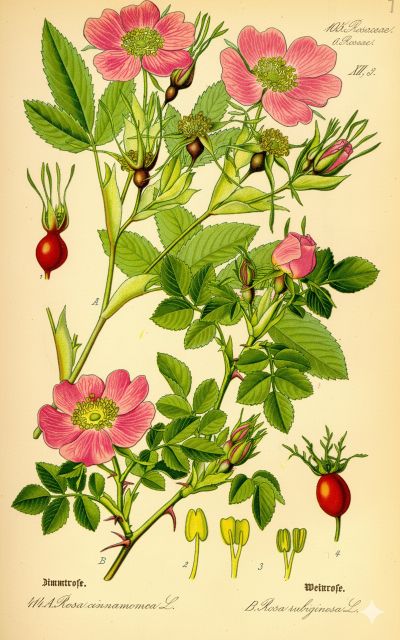May Rose
May Rose
Rosa majalis Herrm.
Family Rosaceae — Rosaceae
Description of Rosehip
May rosehip is a deciduous shrub, 1–2 m, with slender branches covered with thorns. Leaves are odd-pinnate, 5–15 cm, with 5–7 oval leaflets (2–4 cm). Flowers are pink or red, 3–5 cm, solitary or in groups (2–3 flowers). Fruits are oval or round berries, 1–2 cm, bright red or orange-red, with a sweet and sour taste. Varieties: 'Pobeda', 'Vitaminny', 'Krupnoplodny', 'Rosa canina' (Dog Rose, often used for hips), 'Rosa rugosa' (Wrinkled Rose, known for large hips). Flowering in May–June, fruiting in August–September.
Habitat and Ecology of Rosehip
The homeland of May rosehip is Europe, Siberia, Central Asia. It grows in forests, on forest edges, along rivers, in mountains, up to 2000 m above sea level. Cultivated in Russia, Ukraine, Poland. Prefers loamy or sandy loam soils (pH 5.5–7.0), sunny areas, watering 10–15 l/bush every 10–14 days. Propagates by seeds, cuttings, layering. Yield: 1–3 kg/bush. Care: pruning, phosphorus fertilization (10–15 g/m²), protection from aphids, spider mites. Used in landscaping, for hedges, as a honey plant.
Raw Materials from Rosehip
Raw materials: fruits (fructus Rosae), leaves (folia Rosae), roots (radix Rosae). Fruits are harvested in August–September, dried at 40–50 °C (yield 20–25%). Leaves are harvested in June–July, dried at 40 °C (yield 15–20%). Roots are harvested in autumn, dried at 30–40 °C (yield 10–15%). Quality: fruits — red, without mold; leaves — green; roots — brown; moisture ≤12%. Store in airtight containers (fruits: 1 year; leaves: 1 year; roots: 2 years). Weak odor, sweet-sour taste (fruits), neutral (leaves, roots).
Chemical Composition of Rosehip
Fruits: water (80%), sugars (up to 10%), organic acids (citric, malic, up to 2%), pectins (up to 1.5%), vitamin C (up to 1200 mg%), A, E, K, flavonoids, carotenoids, minerals (K, Mg, Fe). Leaves: flavonoids, tannins (up to 4%), vitamin C (up to 100 mg%). Roots: tannins (up to 5%), flavonoids. Calorie content of fruits: 50–60 kcal/100 g (fresh), 250–300 kcal/100 g (dried).
Action and Application of Rosehip
May rosehip has immunostimulating, anti-inflammatory, diuretic, choleretic, antioxidant effects. It is used for avitaminosis, colds, anemia, hypertension, liver diseases, kidney diseases, skin inflammations. Fruits strengthen immunity, improve blood circulation, support vascular health. Leaves help with arthritis, dermatitis. Roots are used for urinary tract inflammations. Fruit juice increases appetite, lowers fever.
Precautions for Rosehip Use
Consumption of >300 g/day of fresh or >100 g/day of dried fruits may cause stomach irritation, diarrhea. Store juice or infusion at 0–5 °C for no longer than 24 hours. For children under 3 years, give ≤30 g/day of fruits. High vitamin C content may affect blood clotting, avoid combination with anticoagulants. Long-term use of root infusions (>2 weeks) requires doctor's supervision. Wash fruits thoroughly due to pesticides.
Contraindications for Rosehip Use
Allergy to Rosaceae, gastritis with increased acidity, stomach ulcer in acute stage, thrombophlebitis, anticoagulant use, urolithiasis, pregnancy, lactation.
Recipes with Rosehip
- Fruit infusion for avitaminosis. Pour 200 ml of boiling water over 20 g of dried fruits, let infuse for 30 minutes, drink 50 ml twice a day, for 10 days.
- Root decoction for urolithiasis. Boil 10 g of roots in 200 ml of water for 15 minutes, drink 50 ml twice a day, for 7 days.
- Compresses for dermatitis. Pour 100 ml of boiling water over 10 g of leaves, let infuse for 20 minutes, apply for 15 minutes, twice a day, for 5 days.
- Juice for colds. Drink 50 ml of fruit juice twice a day, for 7 days.
- Rosehip Syrup for Immune Boost. Blend fresh or dried rosehips, simmer in water, strain, and then sweeten the liquid with honey or sugar to create a vitamin-rich syrup.
- Rosehip Vinegar. Infuse dried rosehips in apple cider vinegar for several weeks. Use the strained vinegar in salad dressings or as a health tonic.
Rosehip in Cosmetics
Rosehip is used for skin care.
- Rejuvenating mask. 20 g of fruit pulp, 10 ml of honey, apply for 15 minutes, rinse, twice a week.
- Lotion for oily skin. 20 ml of fruit juice, 10 ml of water, wipe the skin, once a day.
- Moisturizing mask. 20 g of pulp, 10 ml of yogurt, apply for 20 minutes, rinse, twice a week.
- Leaf infusion for acne. Pour 100 ml of boiling water over 10 g of leaves, let infuse for 20 minutes, wipe the skin, twice a day.
- Rosehip Seed Oil Face Serum. Apply a few drops of pure, cold-pressed rosehip seed oil to the face before moisturizing to reduce scars and hyperpigmentation.
- Rosehip and Clay Mask. Mix rosehip powder (from dried, ground hips) with bentonite clay and water to create a purifying and brightening facial mask.
Rosehip in Cooking
Fruits are used fresh, dried, in drinks, desserts.
- Tea. Pour 200 ml of boiling water over 20 g of dried fruits, let infuse for 10 minutes.
- Jam. 1 kg fruits, 800 g sugar, 200 ml water, boil for 30 minutes, store in jars.
- Syrup. 200 g fruits, 100 g sugar, 100 ml water, boil for 15 minutes, strain.
- Smoothie. 100 g fruit pulp, 100 ml yogurt, 10 g honey, blend.
- Rosehip Jelly. A firm jelly made from rosehip juice, sugar, and pectin, perfect for spreading on toast or pairing with cheese.
- Rosehip Pie. Use a sweet-tart rosehip filling in a traditional pie crust for a unique dessert.
- Rosehip Liqueur. Infuse rosehips in spirits like vodka or brandy with sugar for a homemade digestif.
Tips: Store fresh fruits at 0–5 °C for up to 1 month, dried — for up to 1 year. Remove seeds before cooking.
Other properties of rosehip
Used in ornamental landscaping, for hedges, as a honey plant.




